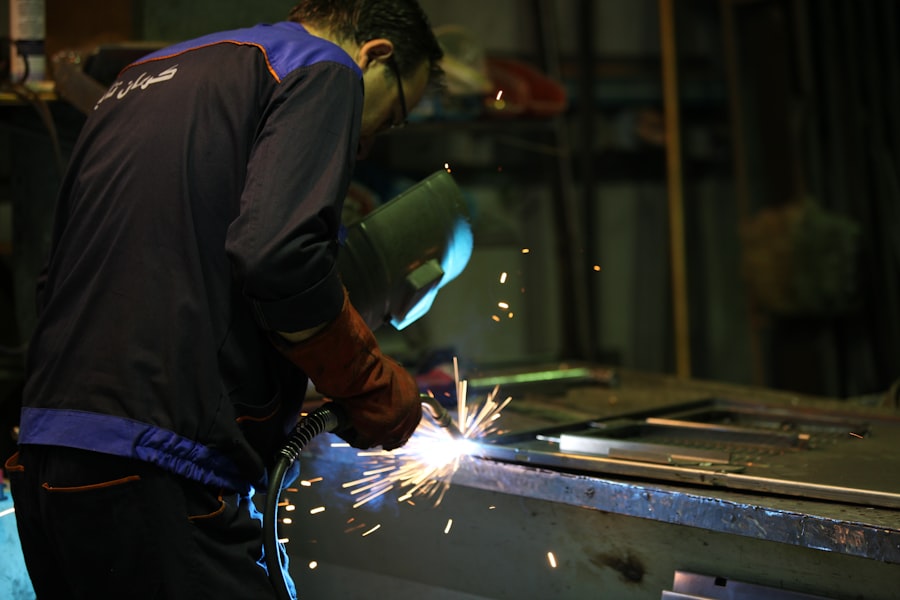Laser hair removal is a popular cosmetic procedure that utilizes concentrated beams of light to target and eliminate unwanted hair. The technology behind this method is based on the principle of selective photothermolysis, which means that the laser emits a specific wavelength of light that is absorbed by the pigment in the hair follicles. When the light is absorbed, it generates heat, which damages the follicle and inhibits future hair growth.
This process is effective for various skin types and hair colors, although it tends to work best on individuals with light skin and dark hair due to the contrast in pigmentation. As you consider laser hair removal, it’s essential to understand that the treatment is most effective during the anagen phase of hair growth, which is when the hair is actively growing. Since not all hair follicles are in this phase at the same time, multiple sessions are typically required to achieve optimal results.
The number of sessions you may need can vary based on factors such as your hair type, skin tone, and the area being treated. Generally, you can expect to undergo anywhere from six to eight sessions spaced several weeks apart to ensure that all hair follicles are effectively targeted.
Key Takeaways
- Laser hair removal works by targeting the pigment in hair follicles with a concentrated beam of light, which damages the follicle and inhibits future hair growth.
- When choosing a laser hair removal clinic or professional, it’s important to consider their experience, qualifications, and the type of laser technology they use.
- Before a laser hair removal session, it’s important to avoid sun exposure, waxing, and plucking, and to shave the treatment area.
- During a laser hair removal session, the technician will use a handheld device to deliver the laser pulses to the treatment area, which may cause a mild stinging or snapping sensation.
- Aftercare for laser hair removal includes avoiding sun exposure, using gentle skincare products, and avoiding activities that may irritate the treated area.
Finding the Right Laser Hair Removal Clinic or Professional
Choosing the right clinic or professional for your laser hair removal treatment is crucial for ensuring both safety and effectiveness. Start by researching local clinics and reading reviews from previous clients. Look for establishments that specialize in laser hair removal and have a solid reputation in your community.
You may also want to ask friends or family for recommendations if they have had positive experiences with specific practitioners. Once you have a list of potential clinics, schedule consultations to meet with the professionals who will be performing the treatments. During these consultations, inquire about their qualifications, experience, and the types of lasers they use.
A reputable practitioner should be able to explain the technology in detail and tailor their approach based on your individual needs. Additionally, don’t hesitate to ask about safety protocols and how they handle any potential complications. This initial meeting is an excellent opportunity for you to gauge your comfort level with the practitioner and their facility.
Preparing for Laser Hair Removal: What to Expect
Preparation for your laser hair removal session is key to achieving the best results possible. Before your appointment, it’s important to avoid sun exposure for at least two weeks. Tanning can increase the risk of complications and may affect the efficacy of the treatment.
If you have recently tanned or have a sunburn, it’s advisable to reschedule your appointment until your skin has returned to its normal state. In addition to sun protection, you should also refrain from waxing or plucking hair in the area you plan to treat for at least four weeks prior to your session. These methods remove hair from the follicle, which can hinder the laser’s ability to target the roots effectively.
Instead, shaving is recommended as it leaves the follicle intact while allowing the laser to penetrate effectively during treatment. On the day of your appointment, arrive with clean skin free from lotions, creams, or makeup, as these products can interfere with the laser’s effectiveness.
The Laser Hair Removal Process: What Happens During a Session
| Stage | Description |
|---|---|
| Consultation | Discussing medical history and expectations with a professional |
| Preparation | Cleansing the treatment area and applying a cooling gel |
| Laser Treatment | Using a laser to target hair follicles and inhibit future growth |
| Post-Treatment Care | Advising on skincare and sun protection for the treated area |
When you arrive for your laser hair removal session, you will typically be asked to change into a gown and lie down on a treatment table. The practitioner will then provide you with protective eyewear to shield your eyes from the laser light. Depending on the area being treated and your pain tolerance, a topical anesthetic may be applied to minimize discomfort during the procedure.
Once you are prepared, the practitioner will begin using the laser device on your skin. You may feel a sensation similar to a rubber band snapping against your skin as the laser pulses target each hair follicle. The duration of each session can vary based on the size of the area being treated; smaller areas like the upper lip may take only a few minutes, while larger areas like the legs may require up to an hour.
Throughout the process, your practitioner will monitor your comfort level and adjust settings as needed to ensure an effective treatment.
Aftercare for Laser Hair Removal: Tips for a Smooth Recovery
After your laser hair removal session, proper aftercare is essential for promoting healing and maximizing results. You may experience some redness or swelling in the treated area, similar to a mild sunburn. This is normal and should subside within a few hours to a couple of days.
It’s also important to avoid sun exposure for at least two weeks following your treatment. If you must go outside, make sure to apply a broad-spectrum sunscreen with an SPF of 30 or higher to protect your skin from UV rays.
Additionally, refrain from engaging in activities that may cause excessive sweating or irritation, such as intense workouts or hot baths, for at least 24 hours post-treatment. Following these guidelines will help ensure a smooth recovery and enhance the effectiveness of your laser hair removal sessions.
Managing Pain and Discomfort During Laser Hair Removal

While many people find laser hair removal tolerable, some may experience discomfort during their sessions. The sensation can vary depending on individual pain thresholds and the area being treated. To help manage any pain or discomfort, communicate openly with your practitioner about your feelings during the procedure.
They can adjust settings or provide additional numbing agents if necessary. If you are particularly concerned about pain, consider taking an over-the-counter pain reliever like ibuprofen before your appointment, but consult with your healthcare provider first. Additionally, some clinics offer cooling devices or topical anesthetics that can help minimize discomfort during treatment.
Remember that while some discomfort is normal, it should not be unbearable; if you find it too painful, let your practitioner know immediately so they can make adjustments.
Potential Risks and Side Effects of Laser Hair Removal
As with any cosmetic procedure, there are potential risks and side effects associated with laser hair removal that you should be aware of before undergoing treatment. Common side effects include temporary redness, swelling, and mild irritation in the treated area. These symptoms usually resolve within a few hours to a few days but can vary based on individual skin sensitivity.
In rare cases, more serious side effects can occur, such as blistering, scarring, or changes in skin pigmentation. These risks are more prevalent in individuals with darker skin tones or those who do not follow pre- and post-treatment care instructions properly. To minimize these risks, it’s crucial to choose a qualified practitioner who uses appropriate technology for your skin type and follows safety protocols diligently.
Maximizing the Results of Laser Hair Removal: Tips for Long-Term Success
To achieve long-lasting results from your laser hair removal treatments, there are several strategies you can implement. First and foremost, adhere strictly to the treatment schedule recommended by your practitioner. Consistency is key in targeting all hair follicles effectively during their active growth phase.
Additionally, maintain healthy skin by keeping it moisturized and protected from sun exposure throughout your treatment journey. Regularly applying sunscreen will not only protect your skin but also enhance its overall appearance and health. Lastly, consider scheduling maintenance sessions as needed after completing your initial series of treatments; this can help manage any regrowth and ensure that you continue enjoying smooth skin long-term.
By understanding each aspect of laser hair removal—from how it works to what you can do post-treatment—you empower yourself to make informed decisions about your cosmetic care.
If you are interested in learning more about laser hair removal, you may want to check out this article on home fashion trends related to laser hair removal here. This article discusses how laser hair removal can be incorporated into your daily routine and fashion choices. It provides tips and advice on how to make the most out of your laser hair removal treatments.
FAQs
What is laser hair removal?
Laser hair removal is a cosmetic procedure that uses a concentrated beam of light (laser) to remove unwanted hair. The laser targets the pigment in the hair follicle, damaging it and inhibiting future hair growth.
How does laser hair removal work?
During the procedure, the laser emits a light that is absorbed by the pigment in the hair follicles. This damages the follicle and inhibits future hair growth. Multiple sessions are usually required to achieve long-term hair reduction.
Is laser hair removal permanent?
Laser hair removal can lead to long-term hair reduction, but it is not always permanent. Some hair may grow back, but it is often finer and lighter in color. Maintenance sessions may be needed to sustain the results.
What areas of the body can be treated with laser hair removal?
Laser hair removal can be used to treat unwanted hair on various areas of the body, including the face, legs, arms, underarms, bikini line, and back.
Is laser hair removal safe?
When performed by a qualified and experienced professional, laser hair removal is generally considered safe. However, there are potential risks and side effects, such as skin irritation, redness, and changes in skin pigmentation. It is important to undergo the procedure under the supervision of a trained practitioner.
Who is a good candidate for laser hair removal?
Laser hair removal is most effective for individuals with light skin and dark hair, as the laser targets the pigment in the hair follicle. People with darker skin tones may require specialized lasers to minimize the risk of skin damage. It is best to consult with a dermatologist or licensed practitioner to determine if laser hair removal is suitable for you.






